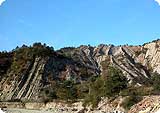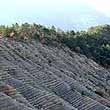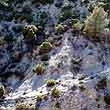soutenance de thèse de Corinne Fesneau – vendredi 14 novembre 2008
 Corinne Fesneau soutiendra sa thèse le vendredi 14 novembre 2008 à 14 h 30 dans l’amphithéâtre d’Orbigny.
Corinne Fesneau soutiendra sa thèse le vendredi 14 novembre 2008 à 14 h 30 dans l’amphithéâtre d’Orbigny.
Titre : Enregistrement des changements climatiques dans le domaine tethysien au Valanginien
Résumé
Le Valanginien est caractérisé par une excursion positive en d13C, témoin d’une augmentation de la productivité, commençant dans la zone à Campylotoxus et qui atteint son maximum pendant la zone à Verrucosum. Afin de préciser les changements environnementaux et leur chronologie, notre intérêt s’est porté sur trois bassins situés dans le domaine téthysien, les bassins vocontien, bétique et lombard. La méthodologie a consisté en l’étude des assemblages argileux, de la géochimie de la matière organique, et en la reconstitution des paléotempératures via la mesure de la composition isotopique de bélemnites. À partir des données obtenues, un scénario est proposé. Les perturbations environnementales semblent débuter dans la zone à Campylotoxus. La fin de cette zone se caractérise par une augmentation de la productivité et de la préservation de matière organique. Ceci entraîne un refroidissement significatif. Des glaces plus ou moins permanentes se forment aux hautes paléolatitudes. Leur formation entraîne une baisse du niveau marin à la limite entre la zone à Campylotoxus et Verrucosum provoquant une augmentation des teneurs en kaolinite dans les trois domaines étudiés. La mise en place d’upwelling favorise également la productivité organique. Une boucle de rétroaction positive semble entretenir des conditions relativement froides jusqu’au début de l’Hauterivien. Le déclenchement initial de la production de matière organique résulte probablement de la conjonction de plusieurs facteurs. Un système d’upwelling existait probablement dès la base du Valanginien. Par ailleurs, le volcanisme aérien enregistré à la base de la zone à Campylotoxus pourrait avoir joué un rôle non négligeable via la fertilisation des océans.




Mots-clés
Valanginien, bassin bétique, bassin lombard, bassin vocontien, bentonite, minéraux argileux, matière organique, paléoenvironnements, paléotempératures
Membres du jury
Thierry Adatte, professeur, université de Lausanne – rapporteur
François Baudin, professeur, université Paris VI – rapporteur
Isabelle Cojan, directrice de recherche, École des mines, Paris – examinatrice
Miguel Company, professeur, Universidad de Granada, Grenade – examinateur
Jean-François Deconinck, professeur, université de Bourgogne – directeur de thèse
Jean Levêque, maître de conférences, université de Bourgogne – examinateur
Helmut Weissert, professeur, ETH, Zurich – examinateur
Record of the Valanginian climatic changes in the Tethysian domain
Summary
The Valanginian is characterized by a ?13C positive incursion, outlining an increase in productivity that started in the Campylotoxus zone and reached its maximum in the Verrucosum zone. In order to detail the environmental changes and their chronology, this work focused on three basins located in the Tethysian domain: the Vocontian basin, the Betic basin, and the Lombardian basin. The method consisted in the study of clay assemblages, organic matter geochemistry, and paleotemperature reconstruction, based on isotopic composition analyses of belemnites. From the data gathered, a scenario is proposed. The environmental perturbations seem to begin in the Campylotoxus zone. The end of this zone is characterized by an increase in productivity and preservation of organic matter.This led to a significant cooling. Ice, permanent or not, appeared at higher paléolatitudes. Their formation triggered a sea-level fall at the Campylotoxus-Verrucosum transition, leading to higher kaolinite contents in the three domains studied. The setting-up of upwellings also contributed to organic productivity. A positive feedback loop seems to have maintained relatively cold conditions until the beginning of the Hauterivian. The production of organic matter has likely been initiated by the conjunction of several factors. There was probably an upwelling system at the beginning of the Valanginian. Also, the aerial volcanism recorded at the beginning of the Campylotoxus zone could have played a significant role in the organic production through the fertilization of oceans.
Keywords
Valanginian, Betic basin, Lombardian basin, Vocontian basin, bentonite, clay minerals, organic matter, paleoenvironments, paleotemperatures
- kc_data:
- a:8:{i:0;s:0:"";s:4:"mode";s:0:"";s:3:"css";s:0:"";s:9:"max_width";s:0:"";s:7:"classes";s:0:"";s:9:"thumbnail";s:0:"";s:9:"collapsed";s:0:"";s:9:"optimized";s:0:"";}
- kc_raw_content:
 Corinne Fesneau soutiendra sa thèse le vendredi 14 novembre 2008 à 14 h 30 dans l'amphithéâtre d’Orbigny.
Corinne Fesneau soutiendra sa thèse le vendredi 14 novembre 2008 à 14 h 30 dans l'amphithéâtre d’Orbigny.Titre : Enregistrement des changements climatiques dans le domaine tethysien au Valanginien
Résumé
Le Valanginien est caractérisé par une excursion positive en d13C, témoin d’une augmentation de la productivité, commençant dans la zone à Campylotoxus et qui atteint son maximum pendant la zone à Verrucosum. Afin de préciser les changements environnementaux et leur chronologie, notre intérêt s’est porté sur trois bassins situés dans le domaine téthysien, les bassins vocontien, bétique et lombard. La méthodologie a consisté en l’étude des assemblages argileux, de la géochimie de la matière organique, et en la reconstitution des paléotempératures via la mesure de la composition isotopique de bélemnites. À partir des données obtenues, un scénario est proposé. Les perturbations environnementales semblent débuter dans la zone à Campylotoxus. La fin de cette zone se caractérise par une augmentation de la productivité et de la préservation de matière organique. Ceci entraîne un refroidissement significatif. Des glaces plus ou moins permanentes se forment aux hautes paléolatitudes. Leur formation entraîne une baisse du niveau marin à la limite entre la zone à Campylotoxus et Verrucosum provoquant une augmentation des teneurs en kaolinite dans les trois domaines étudiés. La mise en place d’upwelling favorise également la productivité organique. Une boucle de rétroaction positive semble entretenir des conditions relativement froides jusqu’au début de l’Hauterivien. Le déclenchement initial de la production de matière organique résulte probablement de la conjonction de plusieurs facteurs. Un système d’upwelling existait probablement dès la base du Valanginien. Par ailleurs, le volcanisme aérien enregistré à la base de la zone à Campylotoxus pourrait avoir joué un rôle non négligeable via la fertilisation des océans.




Mots-clés
Valanginien, bassin bétique, bassin lombard, bassin vocontien, bentonite, minéraux argileux, matière organique, paléoenvironnements, paléotempératures
Membres du jury
Thierry Adatte, professeur, université de Lausanne - rapporteur
François Baudin, professeur, université Paris VI - rapporteur
Isabelle Cojan, directrice de recherche, École des mines, Paris - examinatrice
Miguel Company, professeur, Universidad de Granada, Grenade - examinateur
Jean-François Deconinck, professeur, université de Bourgogne - directeur de thèse
Jean Levêque, maître de conférences, université de Bourgogne - examinateur
Helmut Weissert, professeur, ETH, Zurich - examinateurRecord of the Valanginian climatic changes in the Tethysian domain
Summary
The Valanginian is characterized by a ?13C positive incursion, outlining an increase in productivity that started in the Campylotoxus zone and reached its maximum in the Verrucosum zone. In order to detail the environmental changes and their chronology, this work focused on three basins located in the Tethysian domain: the Vocontian basin, the Betic basin, and the Lombardian basin. The method consisted in the study of clay assemblages, organic matter geochemistry, and paleotemperature reconstruction, based on isotopic composition analyses of belemnites. From the data gathered, a scenario is proposed. The environmental perturbations seem to begin in the Campylotoxus zone. The end of this zone is characterized by an increase in productivity and preservation of organic matter.This led to a significant cooling. Ice, permanent or not, appeared at higher paléolatitudes. Their formation triggered a sea-level fall at the Campylotoxus-Verrucosum transition, leading to higher kaolinite contents in the three domains studied. The setting-up of upwellings also contributed to organic productivity. A positive feedback loop seems to have maintained relatively cold conditions until the beginning of the Hauterivian. The production of organic matter has likely been initiated by the conjunction of several factors. There was probably an upwelling system at the beginning of the Valanginian. Also, the aerial volcanism recorded at the beginning of the Campylotoxus zone could have played a significant role in the organic production through the fertilization of oceans.
KeywordsValanginian, Betic basin, Lombardian basin, Vocontian basin, bentonite, clay minerals, organic matter, paleoenvironments, paleotemperatures
